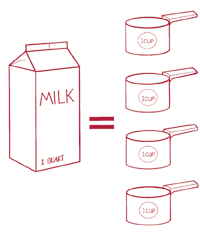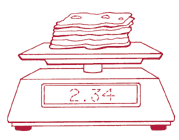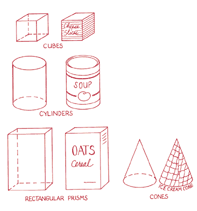|
Math at the Grocery Store
The grocery store is one of the best examples of a place where math is real. It's a great place for practicing measurement, estimation, and quantity. Since trips to the store usually affect everyone in the family, the following activities include various levels of difficulty within the activity.
Allowing your children to participate in weighing, counting, and figuring price per unit versus price per pound will help improve their ability to estimate and predict amounts with accuracy.
 Get Ready
Get Ready (Grades K-2)
What you'll need:
Grocery store coupons and paper
- Involve the family in making a shopping list. Mark checks or tallies next to each item to indicate the number needed. This helps children learn to collect data.
- Involve the children in predicting how much milk or juice will be needed for a week. You might decide to estimate by cups, explaining that 4 cups are equal to a quart and 4 quarts are equal to a gallon. Also, try estimating by liters. How does a liter compare to a gallon?
- Choose coupons that match the items on the grocery list. Discuss how much money will be saved on various items by using coupons.
Parent Pointer - Preparing a shopping list from advertised prices can help children with mental math and estimation. |
 Weighing In
Weighing In (Grades 3-5)
What you'll need:
A grocery scale or your scale at home
- Help your child examine the scale in the grocery store or the one you have at home. Explain that pounds are divided into smaller parts called ounces and 16 ounces equal a pound.
- Gather the produce you are purchasing, and estimate the weight of each item before weighing it. If you need 1 pound of grapes, ask your child to place the first bunch of grapes on the weighing scale, and then estimate how many more or fewer grapes are needed to make exactly 1 pound.
- Let your child hold an item in each hand and guess which item weighs more. Then use the scale to check.
- Ask questions to encourage thinking about measurement and estimation. You might want to ask your child: How much do you think 6 apples will weigh? More than a pound, less than a pound, or equal to a pound? How much do the apples really weigh? Do they weigh more or less than you estimated? Will 6 potatoes weigh more or less than the apples? How much do potatoes cost per pound? If they cost 10 cents per pound, what is the total cost?
- Try weighing items using the metric system. How many grams does an apple weigh? How many kilograms does a sack of potatoes weigh? How does a kilogram compare to a pound?
Parent Pointer - There are many opportunities to increase estimation and measurement skills by weighing objects in the produce section of the grocery store. |
 Get into Shapes
Get into Shapes (Grades 2-4)
What to do:
- Show your child the pictures of the shapes on this page (cone, cylinder, square boxes, and rectangular prism) before going to the store. This will help your child identify them when you get to the store.
- At the store, ask your child questions to generate interest in the shapes. Which items are solid? Which are flat? Which shapes have flat sides? Which have circles for faces? Which have rectangles? Do any have points at the top?
- Point out shapes and talk about their qualities and their use in daily life. Look to see what shapes stack easily. Why do they? Try to find some cones. How many can you find? Look for stacks that look like a pyramid. Determine which solids take up a lot of space and which ones stack well. Discuss why space is important to the grocer and why the grocer cares about what stacks well. (More space allows for more products to be stored.)
Parent Pointer - Recognizing the different shapes that food is packaged in, such as square boxes, rectangular boxes, cones, and cylinders, will help children connect math and volume principles to the real world. |
Math Activities for Grades K-5:
|
|
|